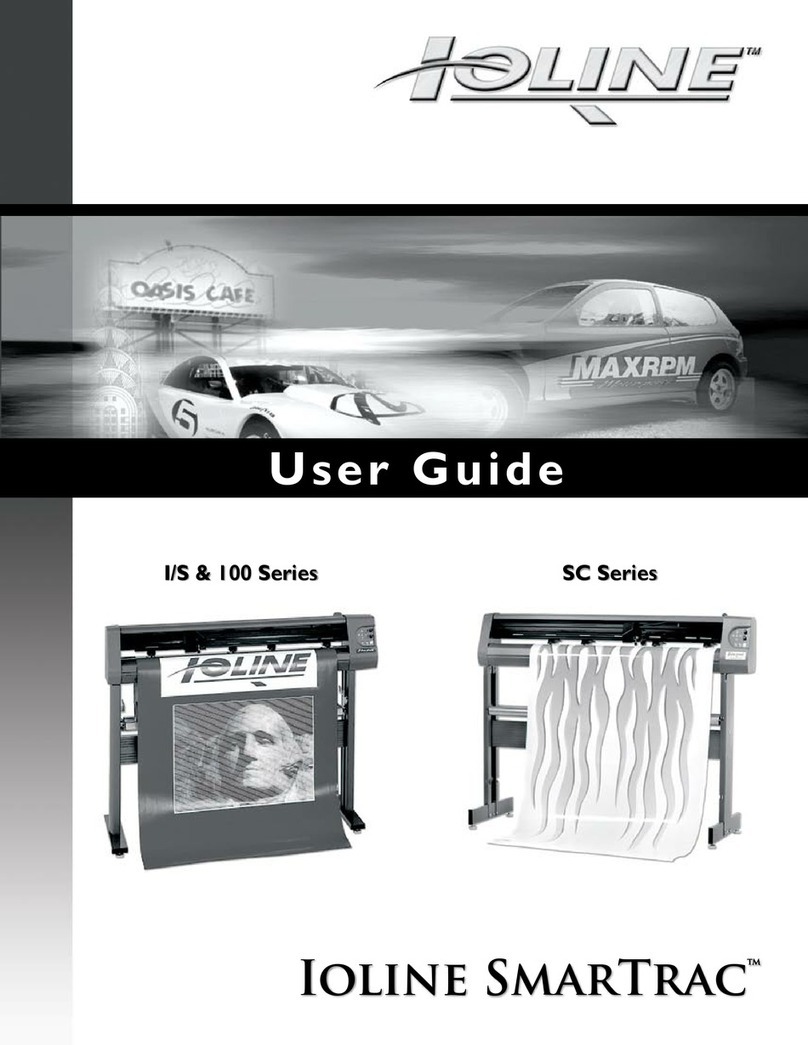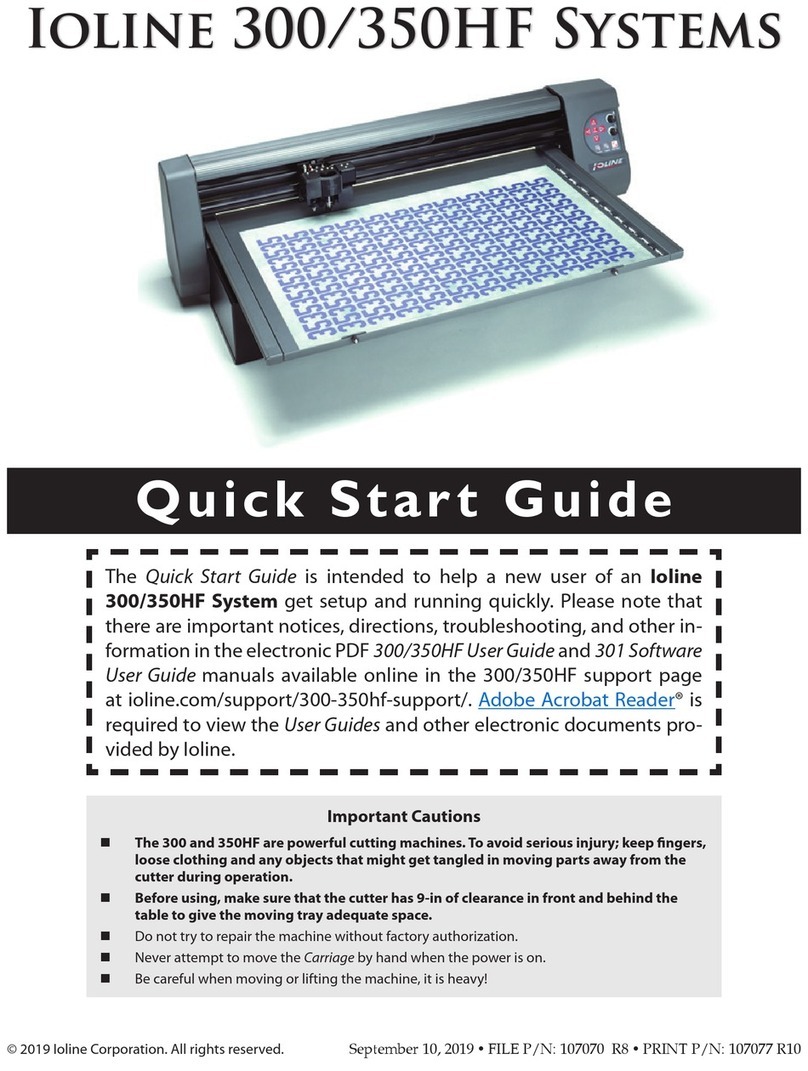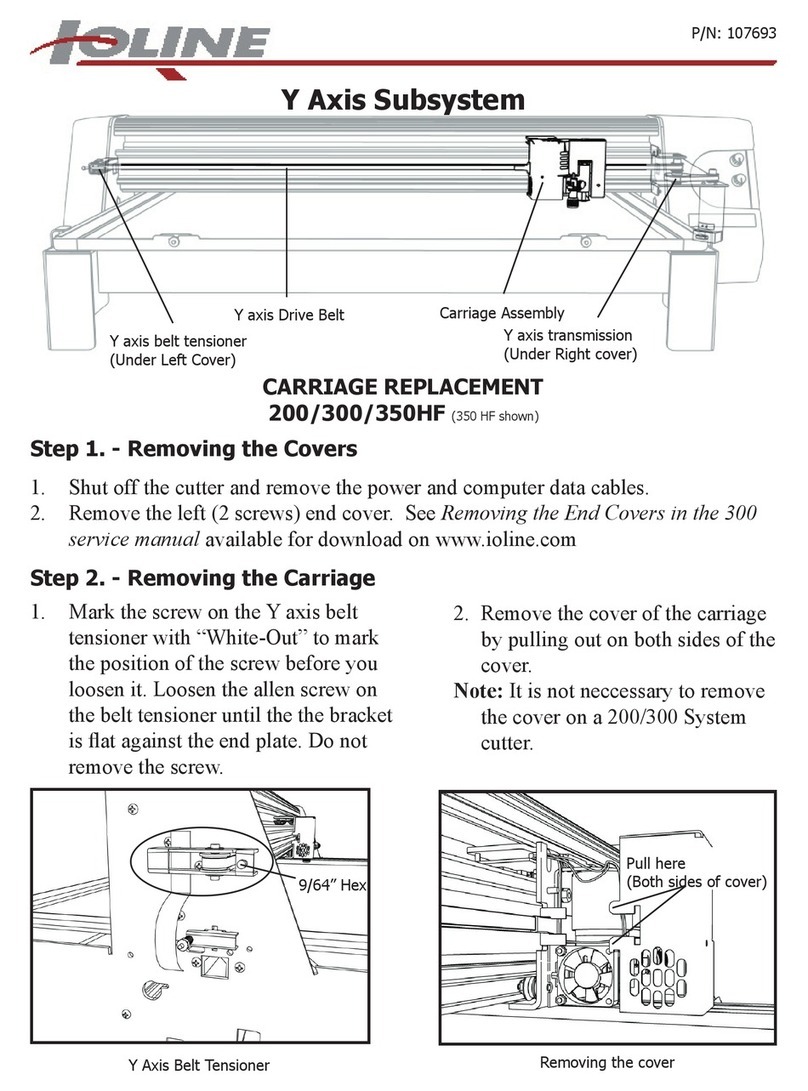10
Ioline
CUTTING A DESIGN
In most cases the design files are sent directly from the design software to the
cutter. If you are cutting material such as Thermo-Flock, or Thermo-Film for
transfer to fabric, you must “Mirror” the image in your design software before
sending to the cutter. If necessary, use the Ioline Control Center software to
send design files, adjust settings and test cutter communication.
General Guidelines
1. Never let the material become suddenly taut between the cutter and a
roll of material during cutting. A service loop of unrolled material is
required for problem free operation. Ioline recommends using the Au-
toloop function (enabled in the Control Center). It will create the re-
quired service loop by gently pulling a set amount of material from the
roll before cutting. Autoloop default is off.
2. Use the Paneling feature in the design software for long designs. Panel-
ing will restrict the length of any X-axis move. Ioline suggests an X panel
size of 10 to 20 inches with no panels greater than 40 inches.
3. Force. Incorrect force can cause misalignment problems over the range of
a long cut. If the force is too high, the material may skew.
4. Prepare a large clean area to work.
Power On
Turn on the computer and the cutter. The cutter power switch is located next
to the power cord on the back. The carriage will move when the power comes
on. Keep hands and loose clothing away from all moving parts of the cutter.
The red light on the front panel will come on when the start up procedure is
finished.
Loading the Material
Note: If Autoloop is not enabled in the Control Center, do not allow the
material to become taut between the cutter and the material roll. Manu-
ally create and maintain a service loop in the rear. See Autoloop in the
Ioline Control Center section for more information.
If using a roll of material: Place the roll between the media rollers.
If using a roll of paper: Hang the paper roll on media roller (as an axle).
Note: Do not place a paper roll on two media rollers.
If using a cut sheet or scrap: No special instructions are necessary.
Aligning the Material and Pinchwheels on the
Optional Stand
Ioline recommends using the, “Typewriter Method,” to align the material to
the platen. The drive shaft is optimized for most common material widths as
well as scraps. Use the drive shaft markers on the carriage rail to find the drive
shaft segments when material is loaded in the cutter.
1. Lift the pinchwheels by raising the pinchwheel lever on the right side of
the cutter. Bring the material up and through the space under the pinch-
wheels. Pull down enough material to reach the media rollers on the
stand.
2. Roughly align the material so that the edges are overlapping the wide-
right-drive shaft segment and one of the smaller segments. Use the drive
shaft markers on the carriage rail to find the drive shaft segments when
they are covered by material.
3. Position the outer-pinchwheels on the material about one inch (2.5 cm)
from the edge. Make sure that the wheels are over a drive shaft segment
using the drive shaft markers on the carriage rail as a guide.
4. Slide the inner-idler wheels (when provided) so that they are as close to
evenly spaced between the outer wheels as possible while remaining
over a drive shaft segment. Use the drive shaft markers on carriage rail to
ensure that the wheels are positioned correctly.
5. With both hands, reach under the stand and clasp the front edges of the
sides of the material hanging from the front of the machine against the
edges of the material hanging from the back of the machine. Pull down-
ward on the material and square the edges so that they are parallel front
and back. Alternatively, align the edge of the material with the edge of
the material roll.
6. While maintaining the material square and taut, clamp the pinchwheels
to the material by lowering the pinchwheel lever on the right side of the
cutter.
7. Warning: While checking alignment with the Arrow keys, make sure
that the material between the material roll and the cutter is never
pulled taut with the drive shaft. Check alignment by using the arrow
keys to move the material forward and back. Observe the material edge to
make sure it is running straight.




































